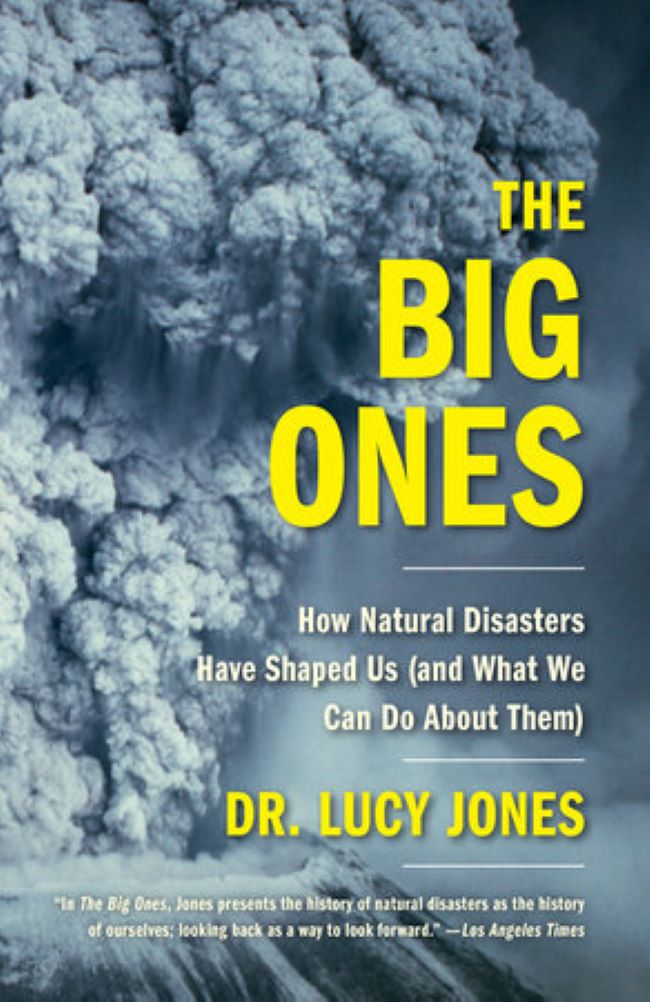
Kelly Kizer Whitt recommends The Big Ones: How Natural Disasters Have Shaped Us (And What We Can Do About Them), a book by world-known earthquake scientist Lucy Jones. What many of us think of as disasters – earthquakes, floods, tsunamis, hurricanes, and volcanoes – are natural events. The resulting disaster isn’t inevitable. Jones discusses some of the “big ones” that changed our world and how we can work to prevent the disaster.
The Big Ones
Lucy Jones was a seismologist for the U.S. Geological Survey for more than three decades. As a native of Los Angeles, she’s done a lot to work with the local government to make the city safer. Since a seismic network was installed in Southern California in the 1990s, the region has never gone more than 12 hours without an earthquake. The majority of these earthquakes are small and not even felt by locals. They are not “Big Ones”. But the Big One, Jones says, is coming.
Jones explains how the faults in Southern California work, and that the San Andreas fault has been worn so smooth that when the next earthquake hits there, there’s nothing to keep it from growing to a magnitude 7 or 8. It’s been 330 years since the last earthquake on this particular part of the San Andreas fault, about twice the average time between its previous quakes. So, Jones says:
Someday, maybe tomorrow, maybe in a decade, probably in the lifetimes of many people reading this book, some point on the fault will lose its frictional grip and start to move. Once it does, the weak fault, with all that stored energy, will have no way of holding it back.
She expects the resulting earthquake could reach up to a magnitude 8.2.
Natural hazards versus disasters
Natural hazards are inevitable; the disaster is not.
This is a common refrain in emergency management circles. We can’t stop earthquakes, wildfires and hurricanes from happening. But those won’t necessarily create a disaster. Disasters happen to communities that are vulnerable. Preparedness, resilience, and a swift response can prevent the destruction and suffering that creates the disaster.
California’s worst natural disaster in its history was not an earthquake. Nor was it a wildfire. It was a flood in the winter of 1861-62. A 300-mile-long (480 km) flood in the Central Valley covered farmland up to 30 feet (9 m) deep. Central Valley simply became The Lake.
This brings up a hurdle to compelling people to plan for future hazards. Our memories are short, and if it did not happen to us personally, we are more likely to discount it and may not even know about it. And, Jones says, hidden dangers provoke more fear than ones we’re familiar with. Earthquakes trigger more fear than the rain that brings a flood.
Big Ones around the world
Jones also ventures far from her native California in this book. You’ll learn about earthquakes in Portugal and China. She recounts the tsunamis of the Indian Ocean in 2004 and Japan in 2011, along with some women in Japan who found ways to help the many victims. You’ll learn more about the volcanic eruption in Pompeii and about one in Iceland in the 1700s that became the deadliest natural disaster in human history. The Laki volcanic eruption lasted for eight months and led to devastation around the globe, killing millions.
Jones sums up her book with some tips for all of us. Some of the advice she has includes:
Don’t assume government has you covered.
Work with your community.
Remember that disasters are more than the moment at which they happen.
Educate yourself.
And one way to begin to educate yourself is to read this book.
Bottom line: The Big Ones by Lucy Jones looks at some of the most destructive natural events in history, how they changed our world and how we can prepare for and recover from them.











